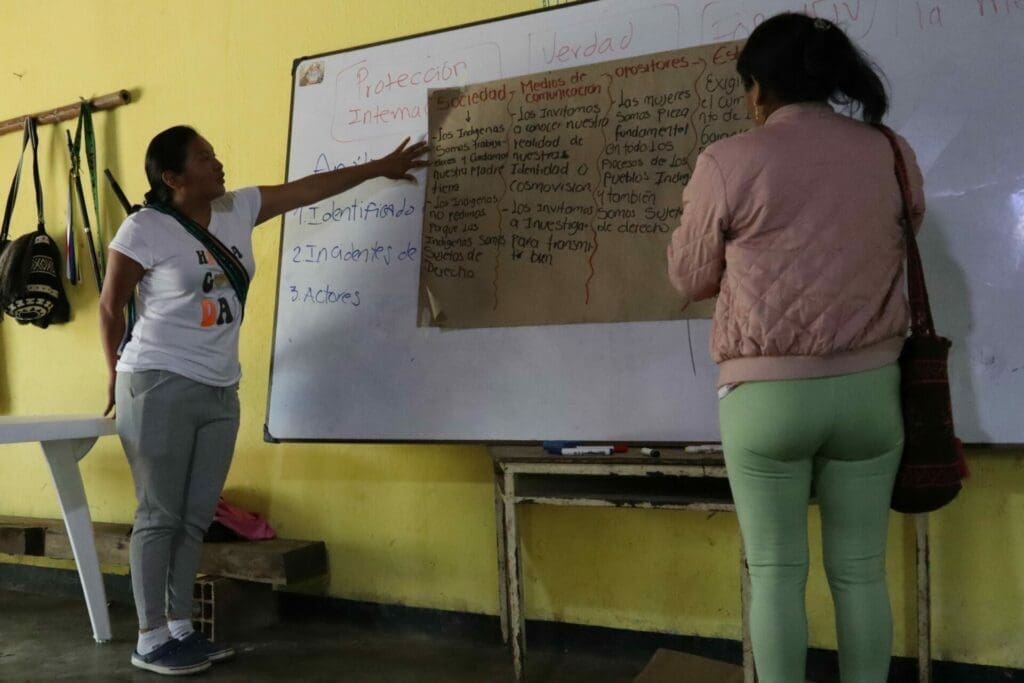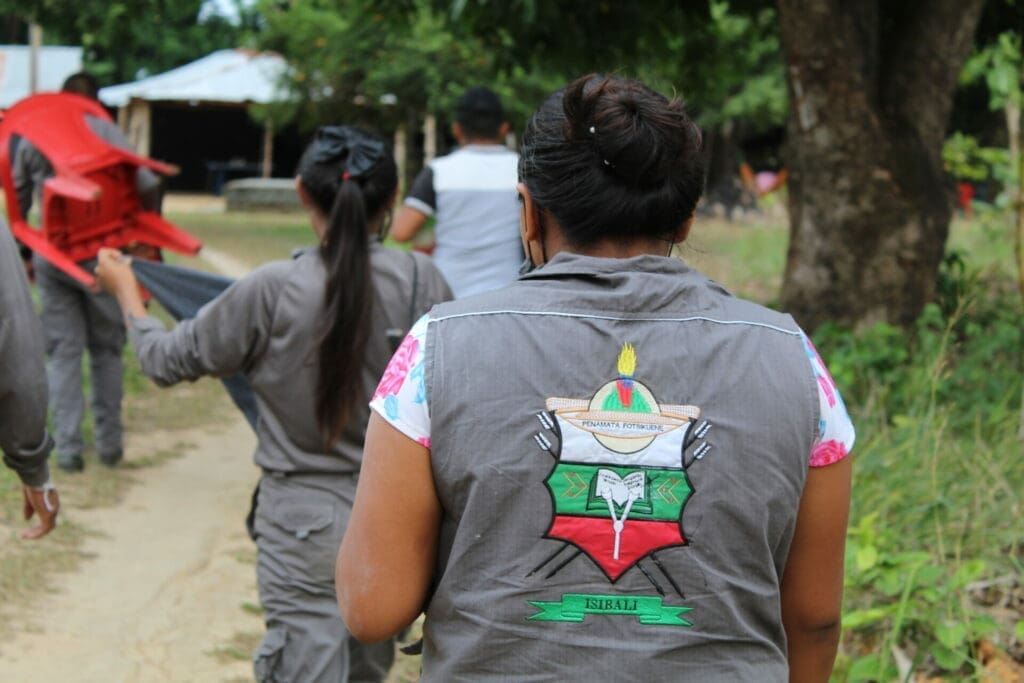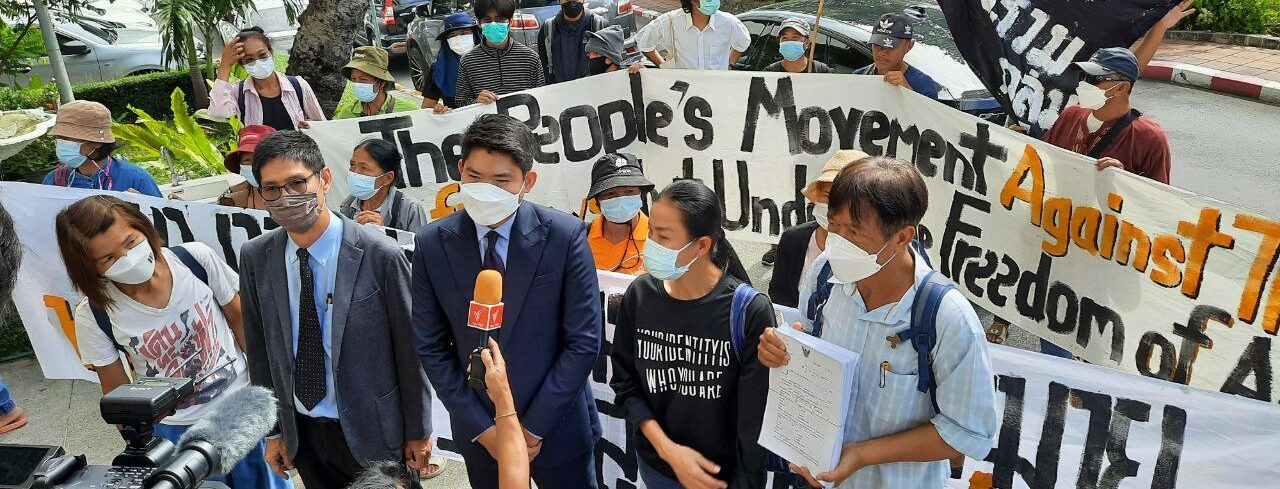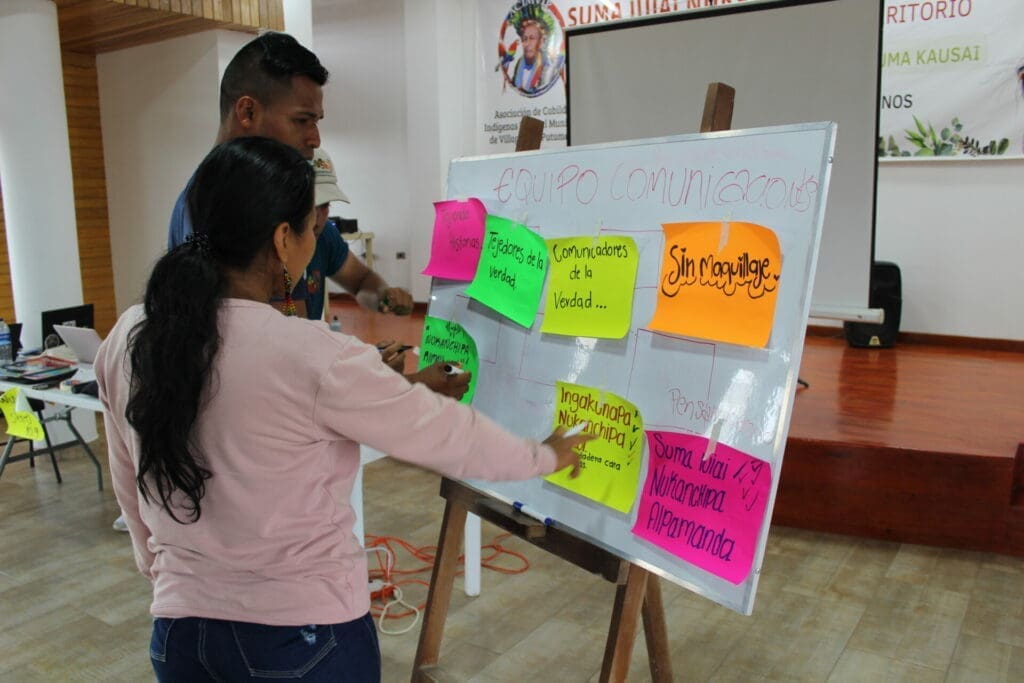[English version below]
La palabra es una de las formas en la que cientos de lideresas y mujeres defensoras resisten en sus territorios en diversos lugares de Colombia. A través de la palabra denuncian las afectaciones que ellas y sus procesos organizativos sufren al recibir acusaciones y vivir de cara a hechos estigmatizantes a su labor de defensa de derechos humanos y del territorio. Así las cosas, caminando la palabra es la manera en la que ellas demuestran que su participación y liderazgo son la clave para continuar impulsando los cambios que requieren sus comunidades y por los que luchan desde hace décadas.
Esa labor de defensa y lucha contra la estigmatización hoy nos llega a través de las historias de tres mujeres indígenas de los departamentos de Huila, Putumayo y Vichada. Tres rostros que se convierten en símbolos de lucha y que, contra toda adversidad, le apuestan a transformar realidades a través de nuevas narrativas.
Ellas participan activamente en el proyecto “Nuevas narrativas locales para combatir la desinformación y la estigmatización sobre la acción de defensa de los derechos humanos y el periodismo comunitario en Colombia”, apoyado por el Servicio de Instrumentos de Política Exterior (FPI) de la Unión Europea e implementado por Protection International y VerdadAbierta.com desde enero de 2023.
Mujeres que luchan contra la estigmatización y el exterminio
En el departamento del Huila está Luz Nidia Finscué, indígena del pueblo Nasa. Esta exgobernadora del Resguardo Nasa Paéz-Huila ha demostrado el poder que tiene resistir y luchar por los derechos de sus comunidades, pero, sobre todo, de las mujeres, con quienes en 2010 crearon el proceso organizativo de Mujeres Nasa, ellas hacen, juntas, camino para un mejor existir.
“Desde mi rol como lideresa insisto en la importancia de que las mujeres asumamos la responsabilidad de la permanencia y la pervivencia de nuestros pueblos, así, las mujeres somos maestras, lideresas que luchamos por transmitir nuestra cultura y cosmovisión. Las mujeres debemos seguir generando procesos, vida, y luchar por nuestros derechos”, asegura Luz Nidia.
En Colombia hay 115 pueblos indígenas reconocidos, distribuidos principalmente -según el Censo Nacional de Población y Vivienda 2018– en los departamentos de La Guajira (20%), Cauca (16%), Nariño (10,8%) y Córdoba (10,6%). De acuerdo con registros del Centro Nacional de Memoria Histórica, entre 1958 y 2019, la guerra en territorios indígenas cobró la vida de 5.011 personas indígenas.

La estigmatización relacionada con su identidad y la falta de respeto a su cosmovisión, a las que se enfrentan a diario en múltiples escenarios, hace que la garantía de sus derechos no sea efectiva.
Ejemplo de ello es el caso del acceso a la educación con pertinencia étnica. Luz Nidia y las mujeres de su resguardo trabajan en contra de las barreras lingüísticas y a favor de una educación incluyente y respetuosa.
“Yo le digo a las mujeres que desde su sabiduría aporten a los procesos comunitarios, a su plan de vida de una manera consciente, propositiva y activa. En nuestras manos está el tema de la identidad, transmitiendo la lengua materna como principio de identidad en nuestros hijos y en las nuevas generaciones, esa es una de las formas en las que luchamos contra la estigmatización y resistimos al exterminio”, agrega la Mayora Luz Nidia.
Defender la vida y el territorio aumenta los riesgos y la estigmatización
En el sur de Colombia está el departamento del Putumayo, allí vive Ginny Alba, coordinadora de derechos humanos de la Asociación de Cabildos Indígenas del Municipio de Villagarzón –ACIMVIP-, quien acompaña la defensa del territorio de intereses empresariales y proyectos económicos llevados a cabo por actores externos. Ginny es otra lideresa que lucha a diario ante los riesgos, la continua estigmatización y la desinformación que sufren los pueblos indígenas y las mujeres por la defensa de su territorio.
“Los conflictos que se han generado en el territorio traen riesgos que se dan por la defensa del mismo. Enfrentamos amenazas contra líderes y lideresas, estigmatizaciones al proceso que venimos desarrollando con la Guardia Indígena, quienes apoyan en el cuidado y control del territorio”, cuenta Ginny con voz pausada.
Estas no son las únicas afectaciones a las que se enfrentan en Putumayo. Según Ginny, el miedo con el que viven las comunidades, y de manera diferencial las mujeres, ante la presencia de actores armados en sus territorios, ocasionan que “nuestro proceso organizativo y los liderazgos de hombres y mujeres estén en una vulnerabilidad más alta”.
Pero, a pesar de esas vulnerabilidades, Ginny asegura que ser parte de su proceso organizativo y liderar acciones en pro de su territorio y su comunidad la llena de satisfacción, y así lo relata: “La importancia de la participación de las mujeres, especialmente las mujeres indígenas, reside en el rol fundamental que ejercemos en ciertas instancias de autoridad y espacios de toma de decisión. Entonces el rol de lideresas y gobernadoras en nuestro proceso organizativo es bastante importante porque se tiene otra perspectiva o una visión más completa sobre las acciones que pueden desarrollarse en beneficio de la comunidad. Eso no quiere decir que seamos más o menos importantes, sino que complementamos tanto los ejercicios comunitarios como el proceso organizativo como Pueblo Inga que hemos venido adelantando”.
Los desafíos comunitarios que enfrentan las mujeres defensoras
Las mujeres, en sus procesos organizativos y de liderazgo trabajan cada día para que la sociedad y la institucionalidad cambien su discurso e incorporen una narrativa que contribuya o transforme el imaginario negativo que se ha construido sobre las personas defensoras de derechos humanos en Colombia.
En el departamento del Vichada nos encontramos con la historia de Milena Rincón, representante legal de la organización Mujeres Artesanas de la comunidad indígena Sikuani y lideresa de su comunidad. Ella asegura que para alcanzar la garantía de sus derechoslo que hay que hacer “en esta época es luchar, resistir, persistir, nunca desistir. Hay que seguir adelante, porque si por ejemplo los niños nos ven luchando ellos se entusiasman y van a seguir luchando por sus derechos”.
En este territorio, las mujeres indígenas realizaron una co-investigación que documenta las barreras que ellas enfrentan en su labor de defensa de los derechos territoriales y ambientales. La investigación, titulada “Mujeres indígenas y cambio climático: juntanza de saberes para la protección de la Orinoquía colombiana”, contó con el apoyo de Protection International. En ella evidenciaron el racismo estructural, el modelo de desarrollo económico extractivista, la creciente pérdida de sus prácticas culturales, los impactos del conflicto armado y la asignación casi exclusiva de los roles de cuidado a ellas por su género, lo que limita el ejercicio de sus derechos y su plena participación.
“En la región nosotras seguimos viendo vulnerados nuestros derechos como defensoras. Nunca nos escuchan, ni tampoco las exigencias que hacemos sobre el territorio, sobre el fortalecimiento de la cultura, por ejemplo, a través de las artesanías. Tenemos líderes y lideresas amenazadas, nos sentimos vulnerados”, cuenta Milena.

Las mujeres de estas tres historias no solo luchan a diario con los retos que implican la defensa de los derechos humanos, sino que deben trabajar por derrumbar algunas barreras al interior de sus procesos organizativos.
“Anteriormente nosotras solamente éramos en la casa (sic), pero en los últimos tiempos ya estamos asistiendo a las reuniones, le estamos metiendo más ganas a luchar, a apoyar a los varones. Ya trabajamos hombres y mujeres para sacar adelante nuestro territorio. La cultura machista ha cambiado un poco, porque no crea que eso es fácil de la noche a la mañana (…) Luchamos porque en la comunidad las mujeres a veces sufrimos estigmatizaciones por parte de los colonos y a veces amenazas, pero a pesar de eso, varias nos metemos en el cuento. Lo importante es fortalecernos para que no nos vengan a atropellar”, concluye Milena.
Desde Protection International y VerdadAbierta.com seguiremos apoyando a las mujeres, sus comunidades y las comunicadoras comunitarias de los departamentos de Bolívar, Cauca, Huila, Norte de Santander, Putumayo y Vichada, donde implementamos el proyecto “Nuevas narrativas locales para combatir la desinformación y la estigmatización sobre la acción de defensa de los derechos humanos y el periodismo comunitario en Colombia”, con el cual buscamos promover un ambiente habilitante para que personas defensoras de derechos humanos y comunicadores/as comunitarios/as, ejerzan su labor de manera libre y más segura en entornos con acceso a información confiable y a nuevas narrativas que combatan la desinformación y estigmatización contra ellas y sus procesos organizativos.
Through words: Women resisting stigmatization and violence in their territories
Language, especially words, is one of the means of resistance used by hundreds of women leaders and defenders in their territories in different parts of Colombia. Through their words, they denounce the damage that they and their organizational processes suffer as a result of the allegations and stigmatization of their work in defense of human rights and territory. In doing so, they are demonstrating that their participation and leadership are the key to continuing to promote the changes that their communities need and for which they have been fighting for decades.
Today we present the challenges of defending human rights and fighting stigmatization through the stories of three indigenous women from the departments of Huila, Putumayo, and Vichada. Three faces that have become symbols of resistance and that, against all odds, are committed to changing realities through new narratives.
They are actively participating in the project “New local narratives to combat disinformation and stigmatization of human rights advocacy and community journalism in Colombia“, supported by the European Union’s Foreign Policy Instruments Service (FPI) and implemented by Protection International and VerdadAbierta.com since January 2023.
Women fighting against stigmatization and extermination
Luz Nidia Finscué, an indigenous member of the Nasa people, lives in the department of Huila. The former governor of NASA Paéz-Huila Resguardo has shown the power of resistance and fighting for the rights of her communities, but above all for women’s rights. Together with other women, she created the Nasa Women organization in 2010 to pave the way for a better life.
“From my role as a leader, I insist on the importance of women taking responsibility for the continuity and survival of our peoples; we women are teachers, leaders who fight to transmit our culture and our cosmovision. We women must continue to generate processes, life, and fight for our rights,” says Luz Nidia.
There are 115 recognized indigenous peoples in Colombia. They are mainly distributed in the departments of La Guajira (20%), Cauca (16%), Nariño (10.8%), and Córdoba (10.6%), as indicated in the 2018 National Census of Population and Housing. Between 1958 and 2019, the war in indigenous territories claimed the lives of 5,011 indigenous people, according to the National Centre for Historical Memory.
The guarantee of the rights of indigenous peoples is not effective, mainly because of the stigmatization linked to their identity and the lack of respect for their cosmovision, which they face daily in multiple scenarios.
One example is the limited access to ethnically relevant education. To address this, Luz Nidia and the women of her “resguardo”[1] are working to break down language barriers and promote inclusive and respectful education.
“I tell the other women that they can contribute their wisdom to the community processes. They can contribute to their life plan in a conscious, proactive, and active way. Our identity is in our hands. We pass on the mother tongue as a principle of identity to our children and the new generations. This is one of how we can fight against stigmatization and resist eradication,” adds Luz Nidia Mayora.
Defending life and territory increases risks and stigmatization
In the south of Colombia, in the department of Putumayo, lives Ginny Alba, human rights coordinator of the Asociación de Cabildos Indígenas del Municipio de Villagarzón -ACIMVIP-, which is involved in defending the territory against business interests and economic projects carried out by external actors. Ginny is another leader who faces daily the risks, persistent stigmatization and misinformation that indigenous peoples and women are exposed to when defending their territories..
“The conflicts that have arisen in the territory bring with them the risks of defending it. Leaders are threatened. There has also been a lot of stigmatization of the process we have developed with the indigenous guard, despite the fact that they are our supporters in the care and control of the territory,” Ginny explains in a calm voice.
But these are not the only consequences they face in Putumayo. According to Ginny, the fear with which communities, and women in particular, live in the presence of armed actors in their territories means that their “organizational process and the leadership of men and women are more vulnerable“.
Despite these vulnerabilities, Ginny says that it fills her with satisfaction to be part of the process of organizing and leading actions on behalf of her territory and her community. “The importance of women’s participation, especially for indigenous women, lies in the fundamental role we play in certain instances of authority and decision-making spaces,” she says. She continues adding “The role of women leaders and governors in our organisational process is very important because they bring a different perspective or a more complete vision of the actions that can be developed for the benefit of the community. This does not mean that we are more or less important, but that we complement both the community exercises and the organizational process as Inga people that we have been doing.”
Community challenges faced by Women Defenders
Women, in their organizational and leadership processes, work every day so that society and institutions change their discourse and incorporate a narrative that contributes to transforming the negative imagination that has been constructed about human rights defenders in Colombia.
In the department of Vichada, we came across the story of Milena Rincón, legal representative of the organization Mujeres Artesanas de la comunidad indígena Sikuani (Women Artisans of the Sikuani Indigenous Community) and leader of her community. She affirms that to achieve the guarantee of their rights, “in these times we have to fight, resist, persevere, never give up. We have to keep going because when the children, for example, see us fighting, they get enthusiastic and will continue to fight for their rights”.
In this territory, indigenous women have carried out a collaborative research project to document the obstacles they face in their work to defend their territorial and environmental rights. The research, entitled ‘Indigenous women and climate change: bringing together knowledge for the protection of the Colombian Orinoquía‘, was supported by Protection International. It highlighted structural racism, the extractivist economic development model, the increasing loss of their cultural practices, the impact of the armed conflict, and the almost exclusive allocation of caregiving roles to them because of their gender, which limits the exercise of their rights and their full participation.
“In the region, our rights as defenders continue to be violated. They never listen to us, nor to our demands about the territory, about strengthening our culture, for example through handicrafts. We have leaders who have been threatened, we feel vulnerable,” says Milena.
The women in these three stories not only face the challenges of defending human rights daily but also have to work to break down barriers within their organizations.
“We used to be in the house (sic), but recently we have been attending meetings, we are putting more effort into the fight, into the support of the men. We work together, men and women, to move our territory forward. The macho culture has changed a bit because it doesn’t change overnight (…) We fight because in the community women sometimes suffer stigmatization from the settlers and sometimes threats, but despite this, many of us get involved in the movement. The important thing is to strengthen ourselves so that they don’t come and run us over”, concludes Milena.
Protection International and VerdadAbierta.com will continue to support women, their communities, and community communicators in the departments of Bolivar, Cauca, Huila, Norte de Santander, Putumayo, and Vichada. In these regions, we are jointly implementing the project “New Local Narratives to combat misinformation and stigmatization of Human Rights Defenders and community journalism in Colombia”, which aims to promote an enabling environment for human rights defenders and community communicators to carry out their work freely and more safely, in an environment with access to reliable information and new narratives that combat misinformation and stigmatization against them and their organizational processes.
[1] Resguardo is a Spanish term that refers to the area of land reserved for use of the indigenous peoples of Colombia.


